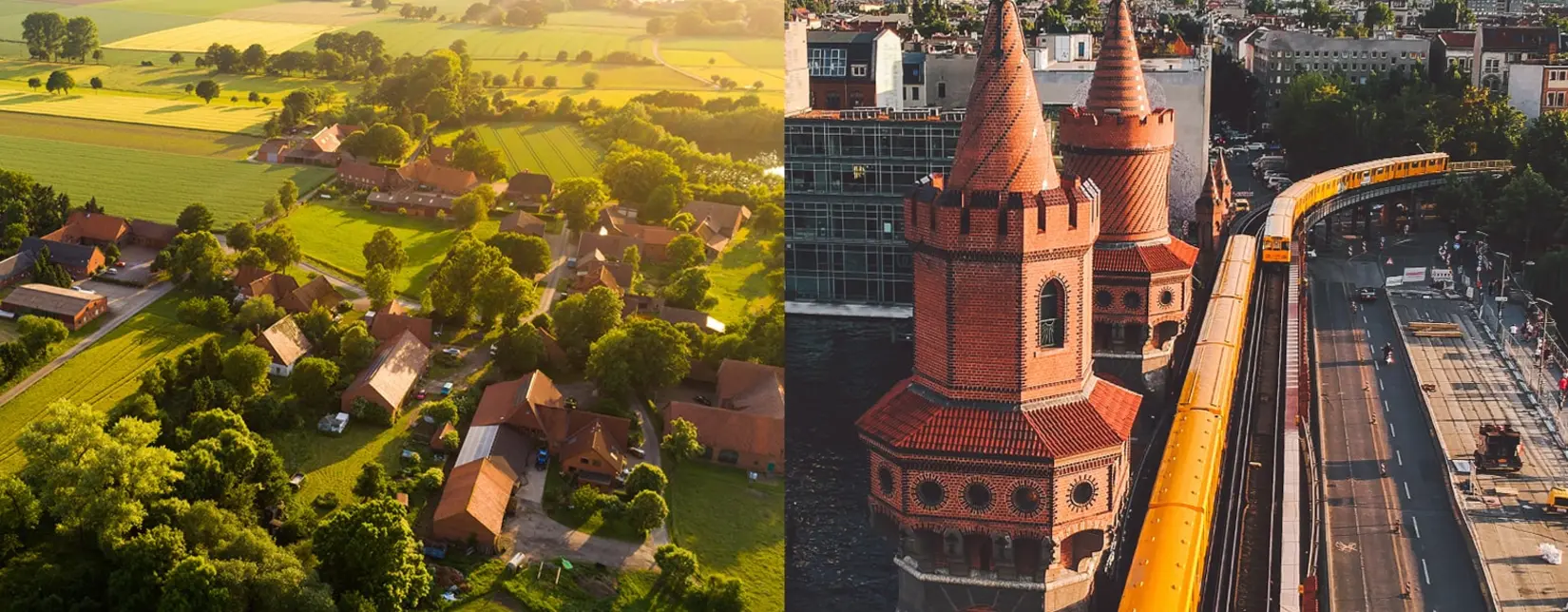
Is it better to live in the country or in the city?
Opinions differ on the question of whether it is better to live in the city or in the country. There are pros and cons to both options, and the question of the best place to live often depends on individual criteria. However, due to the rapid upward trend in real estate prices in cities, people are increasingly opting to move to a rural region. The growing tendency to work from home and the resulting elimination of the need to live close to work has also made people more flexible when it comes to choosing where to live. In a survey conducted by the Society for Consumer Research at the end of 2020, 41% of city dwellers said that they could imagine moving to the countryside in principle. Reason enough to take a closer look at the arguments for living in the city and in the countryside.

Urban exodus versus rural exodus: Historical development
Living in the city is still extremely popular. This phenomenon is known as urbanization. It is by no means a new development: the proportion of the population living in the countryside has been falling continuously since the middle of the 19th century. Industrialization marked the beginning at this time. More and more people moved to the cities to find work. This trend was interrupted during the Second World War, when destruction and hunger drove people out of the city and into the countryside. In the GDR era, this trend was reversed again in the direction of urban flight.
Suburbanization
In countries characterized by industrialization, a more recent development has been observed since the 1990s. Suburbanization refers to the increased movement of the urban population to the outskirts of the city or to the surrounding countryside. As space is limited in the city, but there is plenty of space available in the suburbs and outlying districts, people are increasingly deciding to move there. For this reason, these so-called “bacon belts” are also highly competitive on the real estate market. As a result of suburbanization, the infrastructure is increasingly stretched to capacity due to growing commuter traffic and the core cities are also shrinking. Since the turn of the millennium, more building land has been created in the cities, which has slowed down suburbanization somewhat. However, it has recently experienced a comeback due to the sharp rise in prices in the metropolitan areas.
Are you interested in attractive real estate in Berlin, Leipzig and the surrounding area?
Then contact us now with no obligation. Get an overview of our extensive portfolio and let us advise you personally so that you too can find your dream property.

Urban-rural divide
There are a number of differences between urban and rural areas. Depending on the individual life situation and requirements, they play a major role in the decision to live in the city or in the country.
Infrastructure
Infrastructure is one of the biggest advantages of cities. A well-developed network of public transportation often ensures that a car is not absolutely necessary. In the countryside, on the other hand, you almost always need a car to be flexible.
Mobilität
Related to infrastructure, mobility is also an argument for living in the city. Very often, rural regions are not or only insufficiently connected to the rail network and do not have an adequate bus system.
Free time
In den Städten gibt es ein breites Angebot an Freizeitoptionen, von kulturellen Möglichkeiten über die Gastronomie bis hin zu Sport- und anderen Vereinen. Letztere finden sich allerdings vermehrt auch auf dem Land. Dazu bieten ländliche Gegenden viele Optionen für Aktivitäten im Freien.
Digitization
The expansion of digital networks is still in its infancy in some rural regions. The city clearly has the better offer here. However, this is set to change: various research projects and plans to expand digital networks are intended to promote the connection of rural residential areas.
When it comes to the question of whether the city or the countryside is the healthier alternative, the studies are relatively clear: people who live in the countryside tend to be healthier. They are less likely to suffer from asthma, food allergies or neurodermatitis, and the proportion of people with mental health problems is also lower. However, many cities have changed in recent years, offering more green spaces and therefore more opportunities to spend time in areas close to nature – which also contributes to health. In addition, the medical services offered by doctors and pharmacies are often better in the city. This is a very important factor, for example when deciding whether to live in the city or the countryside in old age.
In the urban vs. rural debate, many people argue that children grow up better and more carefree in the countryside. However, this is not always true, as the range of childcare available in daycare centers and kindergartens and the number of schools are significantly better in cities.
The federal state with the most inhabitants in Germany is North Rhine-Westphalia. According to the Federal Statistical Office, most people live in municipalities with between 20,0000 and 49,999 inhabitants. The largest cities are Berlin, Hamburg, Cologne and Munich.
One of the main arguments for living in the city is better mobility thanks to a well-developed public transport infrastructure. In addition, urban residential areas offer a wide variety of leisure and cultural activities, a good supply of everyday necessities with shopping facilities and a good range of educational opportunities.
Property prices in rural areas are often significantly lower than in urban centers. This applies to both purchase prices and rents. Rural areas also offer more living space. The chances of finding a house with plenty of space and a garden are much better in rural areas than in the city. The crime rate is also lower in rural areas.
